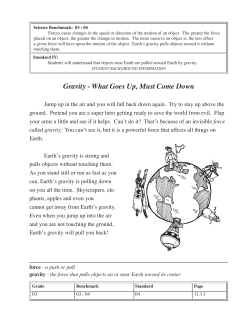
Hydrometers
Hydrometers Document Number: 117 Page: 1 of 2 Balling, or percent of pure sucrose (sugar) by weight. Introduction A hydrometer is an instrument that is used to determine specific gravity. It operates based on the Archimedes principle that a solid body displaces its own weight within a liquid in which it floats. Hydrometers can be divided into two general classes: liquids heavier than water and liquids lighter than water. The standard hydrometer scale is known as the specific gravity scale in which distilled water equals 1.000, the initial point of measurement. Liquids lighter than water are scaled below 1.000 specific gravity and liquids heavier than water are scaled above 1.000 specific gravity. Function, Scale Types and Use The hydrometer is a thin glass tube sealed at both ends and has a graduated or printed scale calibrated to a specific gravity. One end of the tube is bulb shaped and weighted with fine lead shot or mercury. The lead shot or mercury causes the instrument to float upright in a liquid like a fishing bobber. A second glass tube, commonly known as a hydrometer jar, is filled with a liquid being measured. The hydrometer is then placed in the hydrometer jar containing the sample liquid. The specific gravity of the sample liquid is indicated when the level of the sample liquid in the jar aligns with a point on the the hydrometer scale. Depending on which scale is used, the number of times heavier or lighter than water the sample liquid weighs can now be recorded. The scale on the hydrometer can be calibrated to Baume, Brix (or Balling), or Alcohol. • Brix or Balling Scale: A hydrometer calibrated to read in degrees of Brix or Visit our website at benmeadows.com • Baume Scale: A hydrometer which is calibrated to read degrees of Baume, or percent of NaCl (salt) by weight. • Alcohol Scale: A standard “specific gravity” hydrometer that is used to measure specific gravity before and aftera liquid fermented. The difference of thetwo specific gravity readings is referenced to an alcohol scale to determine percent alcohol by weight. All of these scales can also be converted back to specific gravity using a formula. Some hydrometers have one or more scales printed on the hydrometer. To use the hydrometer, fill the hydrometer jar with the sample liquid. Place the hydrometer in the jar and give it a quick twirl to dislodge any air bubbles. Once the hydrometer has settled, take the reading from the appropriate scale. In order for the measurement to be accurate, the sample liquid must be at 60°F. If the liquid is not at 60°F, readings may not be accurate and the measurement should be adjusted. Method of Reading When reading transparent liquids, the eye should be placed slightly below the plane of the surface of the liquid and then raised slowly until this surface, seen as an ellipse, appears as a straight line. The point at which the line sits on the hydrometer scale should be recorded as the reading of the hydrometer. When a liquid is not sufficiently clear—as to allow the reading to be made as described above—it will be necessary TECH INFO © 2014 Ariens Specialty Brands LLC Hydrometers Document Number: 117 Page: 2 of 2 to read from above the surface and estimate as accurately as possible, the point to which the liquid rises on the hydrometer. Accuracy +\GURPHWHUDccuracy depends on three main factors . . . • Cleanliness: The hydrometer, hydrometer jar and the liquid in which the readings are taken should be cleaned properly—especially the surface of the hydrometer and the stem—so that the liquid can rise uniformly, merging into an almost invisible film on the stem. • Temperature: The hydrometer and liquid should be the same temperature of the surrounding atmosphere. This will prevent changes in density during the testing. • Proper Immersion: A hydrometer jar should have an inside diameter of approximately 1 (25mm) greater than the outside diameter of the hydrometer. Commonly Asked Questions Q. How do I convert degrees Baume (salt scale) to a specific gravity reading? A. At 60°F, specific gravity can be calculated by using the following formulas: Liquids lighter than water: Specific gravity = 140 / (degrees Baume + 130) Liquids heavier than water: Specific gravity = 145 / (145 ± degrees Baume) Visit our website at benmeadows.com FREE Technical Support When you have a question, you can rely on our team of technical experts. They’ll answer your questions about product specifications, chemical compatibility, regulatory issues, and general worker safety and health. Call our Technical Support line toll-free: 1-800-241-6401 8 a.m. - 5 p.m. CST, Monday-Friday FREE Catalog When the outdoors is your office, turn to a Ben Meadows Catalog. In it you’ll find thousands of products and our 100% guarantee to stand behind them. Call today to reserve your free copy: 1-800-241-6401 8 a.m. - 5 p.m. CST, Monday-Friday Please note: The information contained in this publication is intended for general information purposes only. This publication is not a substitute for review of the applicable government regulations and standards, and should not be construed as legal advice or opinion. Readers with specific questions should refer to the cited regulation(s), or consult with an attorney. TECH INFO © 2014 Ariens Specialty Brands LLC
© Copyright 2025













